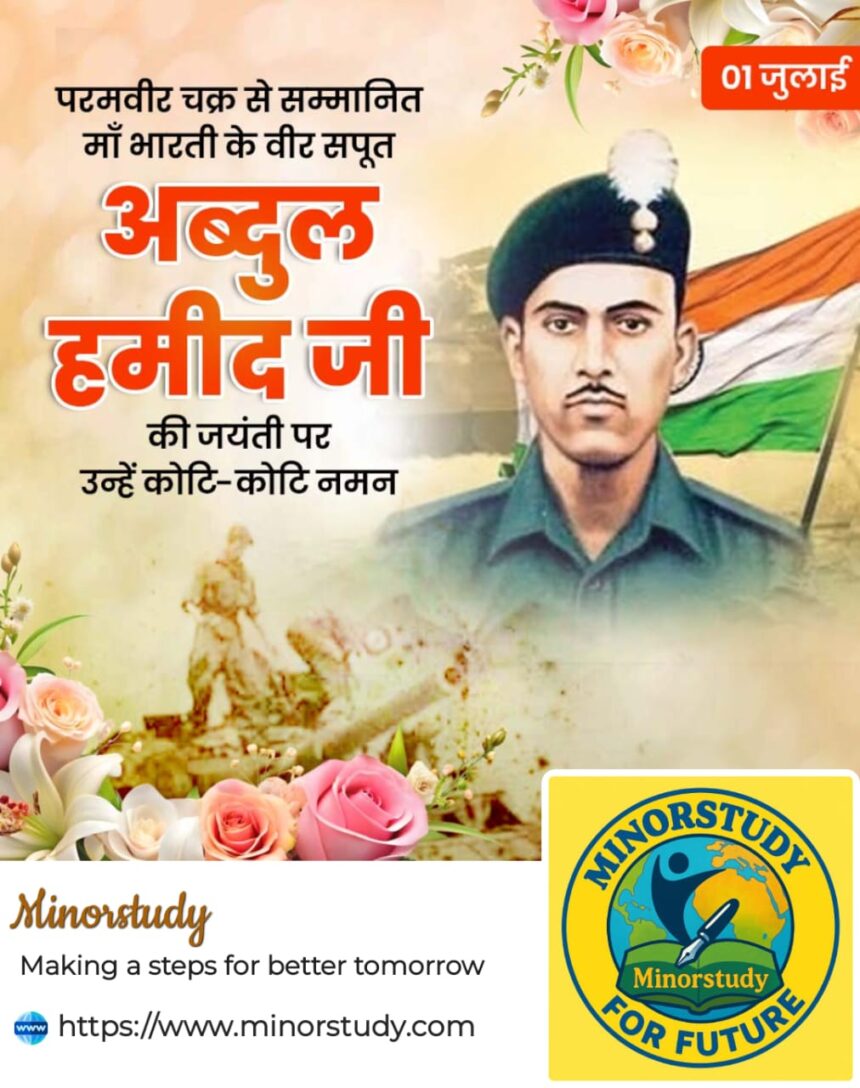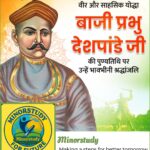5 Heroic Moments from Abdul Hameed’s Life – The Fearless Warrior Who Stopped Tanks with His Soul
Abdul Hameed: In the rich legacy of India’s military valor, Company Quartermaster Havildar Abdul Hameed stands tall as a symbol of unshaken courage, unflinching patriotism, and supreme sacrifice. He wasn’t just a soldier—he was a living embodiment of what it means to defend one’s nation till the last breath.
Known best for his gallantry in the 1965 Indo-Pak War, Abdul Hameed single-handedly destroyed 7 enemy tanks, an act that turned the tide of the war and immortalized his name in India’s military history.
In this article, we explore the history, facts, timeline, significance, FAQs, human behavior, daily life impacts, and more, written with emotion, respect, and storytelling depth to reflect his heroic contribution to our nation.
🧭 Early Life and Background
Full Name: CQMH Abdul Hameed
Date of Birth: July 1, 1933
Place: Dhamupur Village, Ghazipur District, Uttar Pradesh, India
Community: Muslim Rajput
Education: Basic primary education, later joined the Army at the age of 20
Service Branch: Indian Army – 4 Grenadiers Regiment
Service Years: 1954–1965
From humble rural beginnings to the pinnacle of national pride, Abdul Hameed’s journey is a shining example of how patriotism is born from the heart, not background.
🗓️ Timeline of Key Events
| Year | Event |
|---|---|
| 1954 | Joined Indian Army |
| 1962 | Served in the India-China war |
| 1965 | Indo-Pak War began in September |
| Sept 8–9, 1965 | Destroyed 7 enemy tanks using recoilless gun |
| Sept 10, 1965 | Martyred during final tank ambush |
| 1966 | Awarded Param Vir Chakra (Posthumous) |
| 2011 | Dhamupur village renamed to “Shaheed Abdul Hameed Nagar” |
🏆 5 Heroic Facts About Abdul Hameed’s Supreme Bravery
1. Destroyed 7 Patton Tanks in 2 Days
During the Battle of Asal Uttar (Khem Karan sector), Abdul Hameed courageously advanced alone with a recoilless rifle mounted on a jeep, and knocked down 7 heavily-armored Pakistani Patton tanks, which were then considered unbeatable.
His strategy, speed, and accuracy crippled Pakistan’s armored assault, buying critical time for Indian reinforcements.
2. Martyrdom in Action – A Soldier to His Last Breath
On September 10, 1965, while targeting the 8th tank, his position was spotted, and his jeep was shelled. He attained martyrdom on the battlefield, but his bravery became the turning point of the entire operation.
His last action saved many lives and inflicted heavy losses on the enemy.
3. Youngest Param Vir Chakra Recipient in the 1965 War
For his unparalleled gallantry, Abdul Hameed was posthumously awarded the Param Vir Chakra, India’s highest wartime gallantry award. He was just 32 years old.
“He died as a soldier. He lives as a legend.”
4. An Inspiration Beyond Religion or Region
Abdul Hameed is remembered not just as a Muslim soldier but as a true Indian son whose religion was patriotism. He united the nation with his sacrifice.
5. A Village That Breathes His Legacy
His village, Dhamupur, was renamed “Shaheed Abdul Hameed Nagar”, and every year on his birth and martyrdom anniversary, locals and officers gather to salute his sacrifice with pride.
❓ Frequently Asked Questions (FAQs)
Q1. Who was Abdul Hameed and what is he famous for?
A: He was a soldier in the Indian Army who destroyed 7 Pakistani Patton tanks during the 1965 war and was martyred in action. He is famous for his extraordinary courage and tactical brilliance.
Q2. When was Abdul Hameed awarded the Param Vir Chakra?
A: He was posthumously awarded the Param Vir Chakra in 1966, India’s highest military honor.
Q3. How did Abdul Hameed die?
A: He was killed on September 10, 1965, while destroying an enemy tank using his jeep-mounted recoilless gun.
Q4. What was his impact on the 1965 war?
A: His brave actions helped slow and eventually halt Pakistan’s armored advance in Punjab, giving India strategic upper hand.
🌍 Significance of Abdul Hameed in Indian Society
1. A Symbol of Unity
In a nation often challenged by communal narratives, Abdul Hameed’s legacy crushes every divide. His life proves that service to the nation transcends religion.
2. Youth Icon for Courage and Duty
He is a role model for youth, showing that courage doesn’t require big positions, only big hearts.
3. Boost to India’s Morale in Wartime
His acts provided psychological strength to the Indian Army, and strategic delay in Pakistan’s tank movement, ultimately preserving India’s territorial integrity.
🧠 Lessons in Human Behavior
Bravery without selfishness – He didn’t wait for orders; he acted to protect his brothers.
Responsibility before rank – Though a Havildar, he acted as a general in the moment of need.
Sacrifice without recognition – He did not live to receive the Param Vir Chakra; he only lived to fulfill his duty.
🌟 Observance & Memorials
Statue and park in his native village
Postage stamp released by Government of India in his honor
Military cantonments and academies study his tactics in war history
Schools, roads, and awards named after him in Uttar Pradesh and across India
🕊️ Wishing Words on His Day
“Saluting the steel-hearted son of India—Shaheed Abdul Hameed Ji. Your courage fuels our pride.”
“May our children learn about valor through your story, and grow into citizens worthy of your sacrifice.”
“On this day, we bow not just to a soldier but to the very spirit of India.”
📝 Important Highlights
| Topic | Details |
|---|---|
| Full Name | Abdul Hameed |
| Birth Date | July 1, 1933 |
| Martyrdom | September 10, 1965 |
| Regiment | 4 Grenadiers, Indian Army |
| Award | Param Vir Chakra (Posthumous) |
| War | Indo-Pak War, 1965 |
| Hometown | Dhamupur, Uttar Pradesh |
| Achievement | Destroyed 7 enemy tanks alone |
🌺 Conclusion – A Life That Lights the Path of Patriotism
Abdul Hameed Ji was not just a soldier, he was an embodiment of Bharat’s soul—fearless, devoted, humble. His story is a beacon for every Indian, reminding us that freedom comes from sacrifice, and peace stands on the shoulders of heroes.
In times when nationalism becomes noisy, let us remember Abdul Hameed Ji—who served silently, bravely, and selflessly. May his tale forever inspire generations to choose duty over comfort and courage over fear.
“He did not just fire a gun; he fired up a nation’s conscience.”








